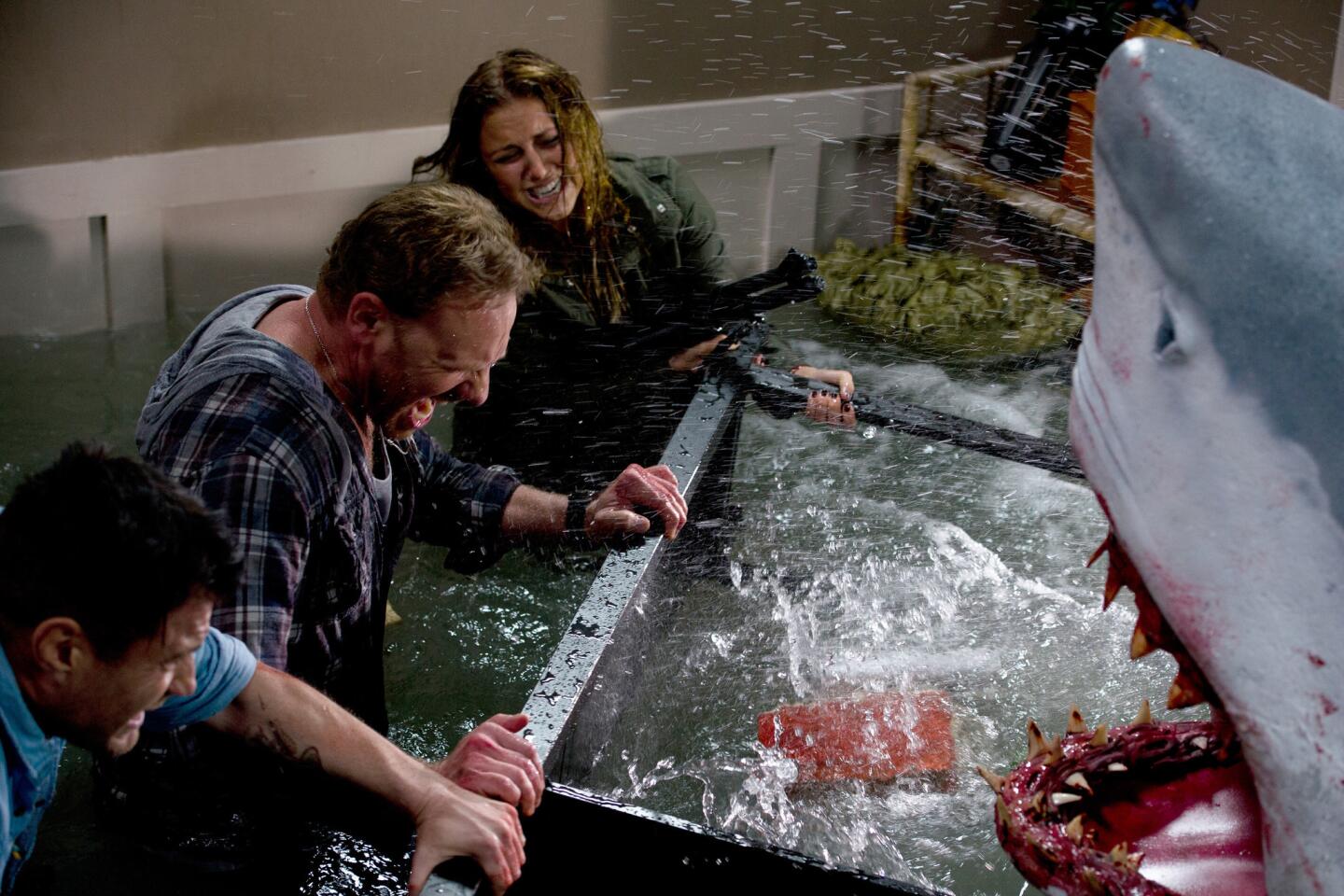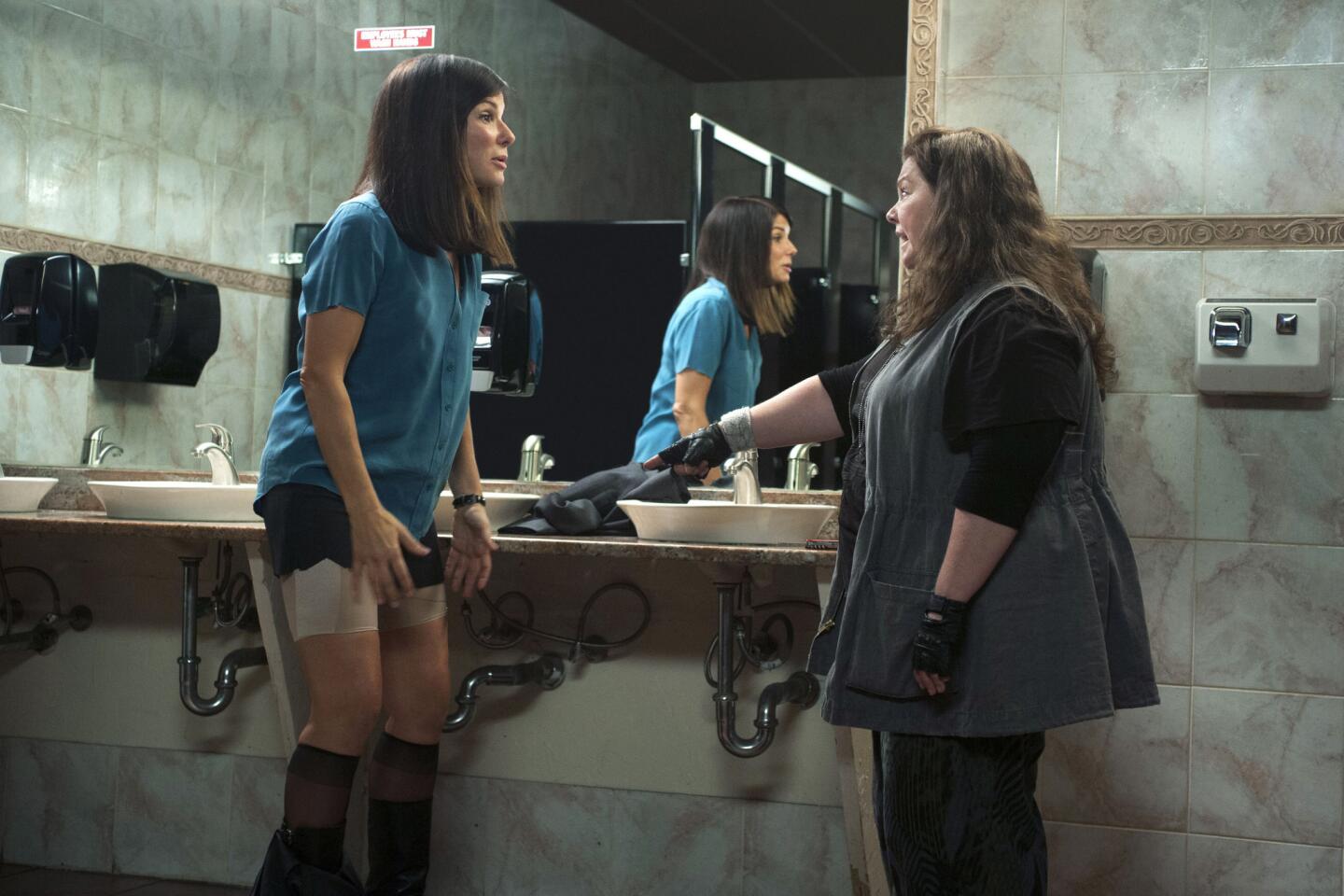Summer B-movies are doing an A-list business
Summer moviegoing is usually about the stars, the spectacle and the sizzle.
But in a trend thatâs mystifying Hollywood, this summerâs box office is being driven by films with modest ambitions, including relatively inexpensive comedies, lower budget animation and horror pictures.
Call it the summer of the B-movie. Like the quickie flicks the studios used to crank out for the back end of double features, these new hits â âThe Heat,â âGrown Ups 2,â âDespicable Me 2â and, as of this weekend, âThe Conjuringâ among them â are drumming up business, while bigger-budgeted offerings such as âThe Lone Rangerâ and âPacific Rimâ struggle to sell tickets.
Itâs these smaller films that have helped summer box-office receipts climb by 14% over last year--defying the conventional wisdom that summer is the time when audiences mainly want to see movies that are big, loud and laden with costly special effects.
PHOTOS: Hollywood backlot moments
The numbers have Hollywood experts grasping for explanations, including studios doing a better job of serving niche audiences on the one hand and consumers experiencing blockbuster fatigue on the other.
âEverything looked watered down and the studios were left trying to distinguish their movies,â said Ted Mundorff, chief executive of Landmark Theatres, affirming the second theory.
This weekend the trend seems to be hitting its apex. âR.I.P.D.,â a supernatural science fiction comedy starring household names Ryan Reynolds and Jeff Bridges that cost at least $130 million to make, is projected to take in less than $15 million at the box office. Meanwhile, âThe Conjuring,â a paranormal-themed film made for the horror faithful at one-seventh the budget, is expected to collect as much as $35 million.
Last weekend âPacific Rimââ a movie that received generally positive reviews but reminded some people of the âTransformersâ franchise â struggled. It cost nearly $200 million but has taken in just $49 million so far.
âGrown Ups 2,â by comparison, cost a relatively modest $80 million and in less than a week has taken in $66 million, virtually assuring a tidy profit. The film didnât try to build a new mythology or dazzle with effects; instead it was a lighthearted confection with recognizable jokes about bodily functions and child rearing meant to comfort more than shock â a kind of B-movie comedy for the modern age.
âIn a way itâs a little bit of a memory piece,â director Dennis Dugan said. âMaybe itâs an alternative to all the big guys blowing stuff up.â
Since the summer moviegoing season began in early May, the biggest-budgeted new movie has now failed to win the weekend box office on eight occasions. In the comparable period in 2012, this happened only three times. Ditto for 2011.
Of course, moviegoers have yet to tire of superheroes â âIron Man 3â and âMan of Steelâ are the summerâs top-grossing movies. And occasionally an expensive star-driven movie, such as Brad Pitt zombie flick âWorld War Z,â has found an audience. But the summer has had a higher number of high-profile flops. All-audience extravaganzas such as Will Smithâs science-fiction film âAfter Earth,â Channing Tatumâs D.C. action picture âWhite House Downâ and Johnny Deppâs western comedy âThe Lone Rangerâ â which cost as much as $225 million and are the closest thing Hollywood has historically had to sure bets â all fizzled in the last month.
PHOTOS: Celebrities by The Times
âThereâs a lot of blood in the water,â said Fox distribution president Chris Aronson. âThere have been more high-profile failures than normal. But itâs hard to castigate the business when business is up,â offering a contradiction articulated often in recent weeks on studio lots.
One of the lower-budget breakout hits is the animated sequel âDespicable Me 2,â which has taken in nearly $250 million, with a budget about half that of Pixar and DreamWorks animated features. Another is âThe Heat,â a cop comedy starring Sandra Bullock and Melissa McCarthy that succeeded precisely by not trying to please everyone; two-thirds of opening-weekend fans were women.
By shrewdly targeting a demographic in the manner of many a vintage B-picture, it has proved far more popular than many of its all-audience counterparts. âThe Heatâ has taken in $40 million more than âLone Ranger,â with little hope of the western catching up. (As it did in the heyday of the B-picture, the rise of the smaller movie of course doesnât necessarily mean an increase in quality; Adam Sandlerâs âGrown Ups 2â garnered a Rotten Tomatoes score barely above 0%).
Those behind the smaller movies say itâs no accident their films are catching on. Producer Jason Blum, who saw his $3.5 million-budgeted âThe Purgeâ gross nearly 20 times that, said that he could afford to take more chances with his movie.
âIf someone at a studio wants to do something unusual like put billboards over L.A. saying âEmergency Services Suspended,ââ Blum said, alluding to âThe Purgeâsâ canny outdoor-marketing campaign, âthey might, but theyâd have to jump through a lot of hoops. With a $3-million movie you can much more easily take a risk.â (Though financed and distributed by Universal, Blumâs movie was made largely free of studio intervention.)
Blum noted that similar sense of financial freedom helped him make satisfying choices within the movie. âI can kill my lead halfway through if the story calls for it. You could never do that with a $100- or $200-million movie.â
Though traditionally B-movies had more self-conscious camp than these new films â think âPlan 9 From Outer Spaceâ â this crop have many of the same hallmarks: familiar plots, escapist intentions, low budgets and high concepts. âThe Purgeâ tells of a world in which all crime is legal for one day â and benefited from a social-media campaign that had users tweeting outrageous things they would do if a purge was real.
Hollywood responds slowly to change. But studios are beginning to react, with studio executives saying theyâre thinking about reducing the number of summer films. The sense is that audiences still want to see spectacle this time of year â they just donât want to see so much of it.
âIt feels like it went a notch too far with the number of movies out there over $100 million,â said Rob Moore, vice-chairman of Paramount, who had one of the rare big-budget hits in âWorld War Z.â âIt felt like there was an unlimited capacity for these movies, but this summer challenged that thinking.â
But shifting models isnât easy. With their gargantuan conglomerate-owned operations, studios, for instance, wonât be able to increase the number of inexpensive genre films to create a modern day version of the B-movie factory.
âI donât see the studios suddenly getting into the microbudget game in a comprehensive way,â Blum said. âTheyâre just not built for that.â
More to Read
Only good movies
Get the Indie Focus newsletter, Mark Olsen's weekly guide to the world of cinema.
You may occasionally receive promotional content from the Los Angeles Times.














